January 2017 December 2016 >>
Blog of Jack and Jude
explorers, authors, photographers & videographers
Sixty Years Ago
 In memory of classmates whose spark was extinguished prematurely,
In memory of classmates whose spark was extinguished prematurely,
Cap’n Jack recalls -.
I was there, on the sports field when the plane flew close over the gymnasium and we kids shouted and pointed excitedly, until the nose and tail section broke off and the plane plummeted. [Read More]
Our photo graces the cover of Cruising Helmsman
Inside, a massive, informative article – Text and photos by Jack and Jude Binder
The Last Eden
Unique, remote, beautiful PORT DAVEY
Abel Tasman may have sailed right past it in 1642, but the chart he produced showed only a smooth coastline, keeping beautiful unique Port Davey hidden for another one hundred and sixty years. Until in 1798, along came Matthew Flinders with his good friend George Bass in the tiny Norfolk, out to prove Tasmania was indeed an island.
With stunning photographs and detailed descriptions of anchorages and attractions, the article is complete with historical details and interesting anecdotes of the aboriginal clans and early pioneers.
Goes well with our latest video.
SUMMER 16 video – Review by Jessica Watson

Jessica Watson
At just 16-years-old, Australian schoolgirl Jessica Watson became the youngest person to single-handedly sail nonstop around the world.
This DVD will make you want to set sail for Tasmania
Jack and Jude have a lifetime of cruising experience and their latest video ‘Off the Tourist Track: Summer 16’ covers their 2016 adventures exploring Tasmania. In addition to showcasing the great scenery that South West Tasmania is known for the DVD gives you a great feel for the area. Jack and Jude have done an impressive job researching local history and share plenty of interesting stories about the original inhabitants and visiting explorers. I loved the footage of Jude helming Banyandah in windy conditions coming into Norfolk Bay. You can really see how comfortable these two are on the water! Very well researched – Useful for those interested in planning a trip to Tasmania -You’ll need their cruising guide for details on anchorages

Practical Features: South Coast Islands, Dover, Hobart, climb the mountain, Con-Dock entrance, Denison Canal, Schouten Island and Swan Island.
Short vid showing a very likable family we’ve gotten to know here in Eden. A beautiful example of the fun loving, well mannered, inquisitive children that live life afloat.
Peace on Earth – Goodwill to All
Tiring turbulent times ends well
Like a twister, finishing those thousand maintenance items unleashed a whirlwind two days. But before that, a beautiful farewell party with the family and special arrivals. Must have been a dozen kids climbing trees and on expeditions exploring the fields.
Departure morning arrived on the 12th of December 2016, and after ferrying several loads of clothes and supplies, we started un-docking Banyandah. Then we took the barge boards home, leaving the shore lines and bower anchor to sort. After doing that we motored faster than we thought we would, towards the trawler harbour to take on water. Truth is we haven’t slipped our lady since Albany, WA. When was that? Egad! Yonks ago.
Presto-chango. In the blink of an eye, like passing through a concave mirror suddenly it’s smaller spaces, less walking, more precise steps, and instantly we’re a tighter team and loving it. Credit to dear Banyandah – gives us space, yet we can communicate easily.
Drama within minutes
Crossing the dangerous Ballina River Bar was easy pezy – quiet morning, easy motion, serene – until the engine overheated and exploded like Mt. Vesuvius shooting boiling water onto our fridge compressor and veggie locker!
Poor thing – built in the fifties, our donk first powered a road truck until the loads grew beyond the engine’s strength. That’s when we happily took it off their hands and rebuilt it as our own. Nicknamed “The Donk,” cause she’s mechanically noisy, she has powered Banyandah from the beginning in 1973. Then it was, in ever-increasing circles, that veteran donk of ours saw us around several oceans, then around the world. More recently, around Australia a couple of times.
When our donk blew steam and suffered a loss of power, we were close along the coast, with a gentle onshore breeze ghosting us along at a knot or two. Leaving for destinations south, we’re full, every locker chock-a-block, making getting to things, like the engine water filler, painfully frustrating to the max. While we took the land breeze, slowly gaining the safety of more sea room, the next three hours were hot and dirty inside the engine compartment, tracking down the fault.
Easy, Sweet First Voyage
Ouch! Only so much could be checked in the red hot engine space. So, after the obvious, like checking the raw water filter for a blockage and vee belt tension, we waited for the engine space to cool before continuing the search.
Attempting to re-enter Ballina without an engine would be dangerous. As would be entering the Clarence River, our original destination. Therefore, we sailed through the night for Coffs Harbour. A good decision. Ever so slowly, the gentle land breeze swung to the north and increased slightly. Our journey, rather slow, but easy and comfortable. Perfect for a first day at sea. Then, as the sun set, the wind increased, making the night sail heavenly under a bright full moon. Taking six hour watches, Jack till midnight, Jude till dawn, both of us managed a little rest. Even better, daybreak found us just a few hours from Coffs.
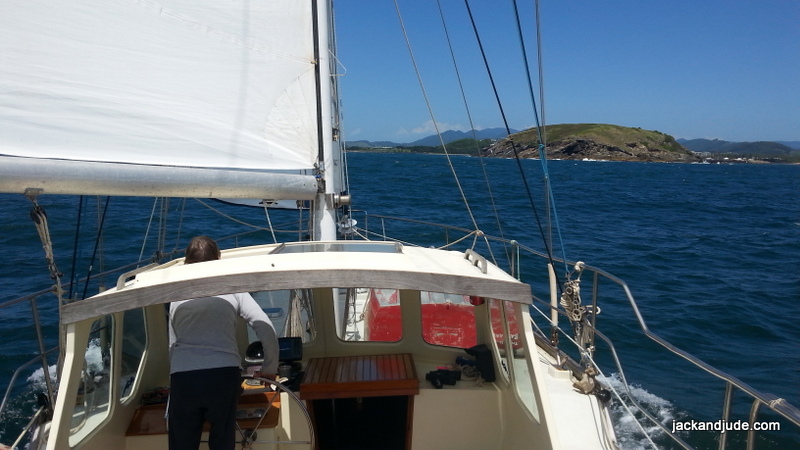
Sweet and easy overnight passage – Mutton Bird Island, Coffs Harbour ahead
Around 11 AM we flew past its breakwall, under full sail, then dropped our hook just off the old timber jetty.
Perfect! Now let’s find the engine problem. First though, a few beers to celebrate, and a good night’s rest swinging on the anchor.
Discovery at Coffs
I have a notebook where I record day to day stuff – Lists of things to do – Prices – Contacts – Job priorities – Any detail that I may want to remember. I’ve been doing this for years. As a result, there’s a bookshelf bursting with exercise notebooks dating back to 1968 when Jude and I drove overland from the UK to South Africa. It’s amazing to read notes on the Sahara, Congo and our troubles in East Africa.
But that’s not what I want to share with you this morning. After recovering from our first sail in six months, an overnight passage where little sleep was found, I squeezed into the engine space and lay atop the now cool engine, and began removing the saltwater pump. Straightaway, I noticed that the pulley could move in and out. Hmm, could that be the problem? Encouraged, I then tried to rotate the freshwater pump. What! Shocked, I found the pump seized solid as if petrified stone!
Wow! That very essential pump had suffered bearing failure, and that had caused our catastrophic explosion. Damn good thing it hadn’t gone belly up thirty minutes earlier when crossing Ballina’s dangerous river bar. In those windless conditions, with seas crashing against both stone breakwaters, we might have lost our lady. Crikey, We sure rely on our engine to get us out of tight spots, and that image has me keeping a closer eye on our baby.
Fortunately, we carry substantial spares, and deep in a locker sat a replacement pump. Hunched over, with grease up to my elbows, I changed the fresh water pump. And then renewed the Jabsco salt water pump impeller. The impeller itself was in good nick, but the nib stopping the shaft from shifting in and out was gone.
Finishing late, Jude had lovely heated a bucket of water for a cockpit shower then, after a wonderful feed, I’m going to bed with a big grin on my face thinking – “problem solved.”
Next day we test ran the donk while still on the hook. Hmm, high revs rose the temp higher than normal, but let’s see what she’ll do under load. So we picked up our hook and started a run around the harbour. Crikey! That damn temp needle kept rising past 200 F. Killing the engine before it could vomit more boiling water, Jude and I quickly drop our hook where we came to rest.
What the? Thought we’d solved the problem – so, what’s up? Tracing the cooling system in my mind, it soon came to rest on the heat-exchanger. That thing cools the engine’s fresh water using seawater. And, it’s got history. Over the years, we have cleaned its small tubes a few times and recently had the whole thing de-scaled and re-soldered. So, theoretically, it should be good. Accepting this prompted a call to a knowledgeable friend of ours who suggested we may have blown the head gasket. Oh my! We didn’t want to hear that.
We do carry a spare top end gasket set on board, but removing the weighty six cylinder head from our Perkins P6 in an exposed anchorage like Coffs didn’t seem wise. And taking a berth in the marina was not an option because it was closed after taking a massive onslaught during a winter east coast low that had damaged the breakwater and berths.
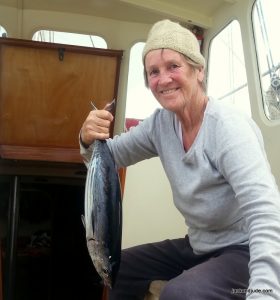
suicidal skip jack made an excellent lunch
Beating the Blow
Next morning at 4 AM, we were up preparing to try our luck at escaping using the engine. In windless conditions, we slowly motored towards the opening, watching the temp gauge intently. Beauty, we got out with little movement on the dial and thus encouraged kept going towards the safety of open sea. As we increased revs, the needle began to climb, slowly at first, then rapidly till it hit that danger mark at 200 F.
Oh No! I pulled the throttle back to idle, and in a few minutes happily watched the needle start to go down. Wow, that was unexpected. Up and down went the needle as we adjusted power, and here came another clue. The temperature gauge dropped extraordinarily rapidly – like losing 40 F in a minute! No engine can cool down that quickly, so we started thinking that the sensor was stuffed.
A cold front was forecast to run up the coast in 36 hours, bringing near gale force headwinds. Preceding it were favorable north winds. And even though we didn’t have a clean bottom, I’d worked out that we could manage the distance to Port Stephens, another port that can be sailed into, given the south going current should give us a lift of at least a mile an hour. As it turned out, the sail down the coast had the wind right behind us producing a rather rocky rolly motion that continued into the dark, showery night. Plenty of big ships and the usual mob of fishing boats to dodge. When we changed watch at midnight, Jude was complaining about no sleep, and when it was my turn, I found much the same in the rolly motion. Nevertheless, we made good speed and by daybreak had a little more than forty miles to our destination.
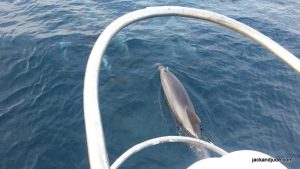
Too Slow! the pod of dolphins seemed to say
Daybreak cleared away the clouds, which took the wind with them, leaving us looking for an alternative secure anchorage. Alas, there was none. Thankfully, the breeze, although light, kept us moving at 3 knots, which we figured would put us in Port Stephens with time to spare before the change.
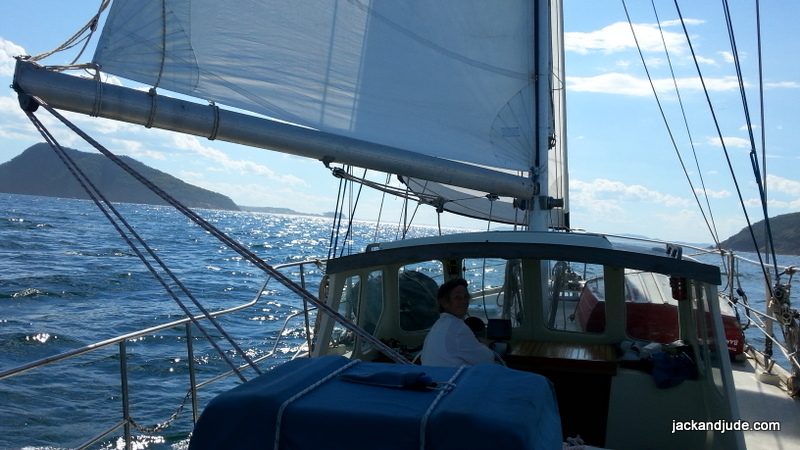
Entering Port Stephens under sail
Memorable Sail
You know, it turned out to be one of those memorable sails, not super fast, but we were able to navigate through the islands just before Port Stephens, doing all sorts of corrections for wind and current, creating overfalls and whirlpools. And luck stayed with us. The light breeze became a steady onshore sea breeze right up our bottom which allowed us to buck the outgoing tide, beating it ever so slowly we inched our way past the headlands, slid past the breaking entrance sand bar, and into Port Stephens main basin. Jeez, that’s work we really enjoy. Watching Nature’s elements, making corrections to use its forces to win the day. In the end we sailed right past Shoal Bay near the opening, past the harbour at Nelson, to drop our anchor once again under sail in a quiet little bay fronted by pretty Dutchman’s beach.
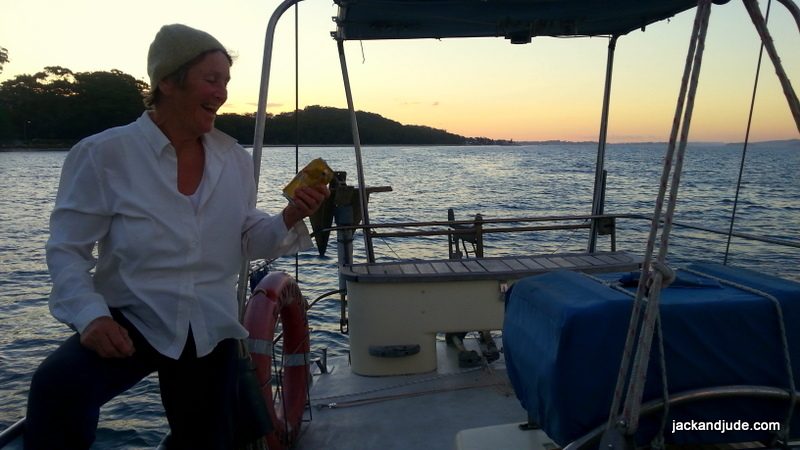
anchorage at Duchman’s Beach
Wow! We were whacked! After a couple of celebratory sundowners and a curry made with the tuna caught earlier, we hit the bed exhausted. When the front stuck at midnight, vaguely in the depths of slumber, I heard the roar, but as our ship wasn’t being knocked about, turned over to slumber till dawn.
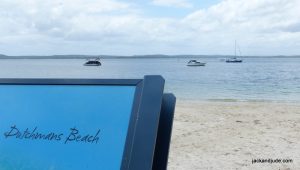
Banyandah off Dutchman’s Beach
Troubles in Threes!
While safely anchored off Dutchman’s Beach near Nelson in Port Stephens, I removed the water temperature sensor after finding it a bit corroded. It had a hard life, and I was hopeful its poor condition was responsible for the fluctuating readings on the temp gauge. I was right. After cleaning it and re-attaching the probe, it actually gave a more steady reading, but unfortunately not for the better.
Then, when we found evidence of water mixed with oil near the head/block joint, added to the ragged running immediately after start-up, we became convinced we’d compromised the head gasket. That’s bad news when far from home on the cusp of the year’s biggest journey.
Plans were formulated and action taken to tackle the problem and get us back on an even keel. We booked ourselves into a marina at Newcastle for the Christmas Holiday. It’s there we’ll do the work needed to get us back to 100% . Jude’s elated! Telling her relatives back home in Newcastle Upon Tyne, England, that she’s going to celebrate Christmas in Newcastle!
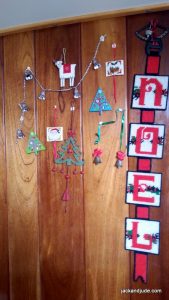
MERRY CHRISTMAS!
We’re hoping Santa slides down our mast to fix our engine !!
Sail Away Start
When the tide turned in our favor, we hoisted all sail for open sea and enjoyed a memorable sail past Anna Bay then close along the fabulous Worimi Sand Dunes, 32 kms of the longest moving sand dunes in the southern hemisphere. What a treat. All the better when the wind forecast came true and under headsail alone, we sailed into the major commercial port of Newcastle, the largest bulk shipping port on the east coast of Australia and the world’s leading coal export port. Using engine power just at the last, to get alongside the end of the marina tee. Early the following morning, in the still conditions, we slipped into our assigned berth, secured Banyandah, and straightaway went to drown ourselves under lovely hot showers. Sure beats stand-up cockpit douches. Following that, in holiday clobber, we went off to celebrate surviving another year.
The first European to explore the Newcastle area was Lieutenant John Shortland in September 1797. His discovery of the area was largely accidental; as he had been sent in search of a number of convicts who had seized the HMS Cumberland.
While returning, Lt. Shortland entered what he later described as “a very fine coal river”, which he named after New South Wales’ Governor, John Hunter. He returned with reports of the deep-water port and the area’s abundant coal. Over the next two years, coal mined from the area was the New South Wales colony’s first export.
Newcastle gained a reputation as a “hellhole” as it was a place where the most dangerous convicts were sent to dig in the coal mines as harsh punishment for their crimes
Being strangers in a big city at Christmas, we joined a thousand others from all walks of life for a free Christmas lunch put on by the Samaritans in an open ex-railway shed found in the foreshore park. Read more on that here.
Replacing the seized freshwater pump had not stopped the engine from overheating, which left us with several possible culprits. A blown head gasket can let the heat of ignition reach the cooling water, and this was supported by ragged running and voluminous white smoke at start-up. Our temperature gauge also came under suspicion when its probe fell to pieces, and of course the heat exchanger, even though it had been professionally overhauled two years earlier, but it could have been choked. Therefore, we decided to remedy the lot.
Once secure in a city filled with all kinds of shops that were still trading over the Christmas period, I unbolted and lifted the cockpit floor, exposing our sick engine. Our major goal was to replace the head gasket, and we carry a top end gasket kit which includes a new head gasket. A good idea, especially with an engine of this vintage.
Newcastle put on extreme summer heat and conditions were exhausting as I climbed up and down, in and out of the engine space, removing bits while having to be exceptionally careful not to drop something important down into the bilge under the engine – all the while maintaining 100% secure footing in and around what is basically a hole to the very bottom of our vessel.
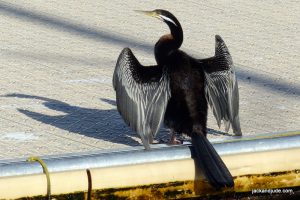
Similar to cormorants, Australasian Darter drying its wings. Darter vocalizations include a clicking or rattling when flying or perching.
You may recall that Jack and Jude have hitchhiked pretty much all over the world. Yes, we know, it’s not accepted by modern folk – too many crazies out there is said. But we have never found that. Instead, we have met so many interesting, nice folk with tales of their own, curious and interested enough to pick us up. An example that gladdens our hearts happened a few days after Christmas when the roads were crowded with bargain shoppers. It was stifling hot when Jude and I toddled off by bus to the marine store to purchase anodes and dinghy paint. From there, when trudging back towards the bus stop to go to a new destination to purchase a replacement temperature gauge, a horn beeped from across a side road and a fella asked where we were going, saying, he’d seen us walking the other way in the heat about an hour before. “Supercheap at Kotara,” I answered and his reply was, “I’m going that way.” And so, we jumped in and immediately began chatting, both of us relaying a little history, eased any concerns. We’re savvy enough to know a good person from someone wicked. Greg became entranced by our tales of wandering the world, fending for ourselves, fixing things. And not having much to do, he offered to chauffeur us around. What a nice chap. Proved once again that most folk are genuinely nice. We had a similar experience in Port Stephens – a young tradie pulled over and was so excited to meet real hitchhikers. Later, another man gave us a lift back to our boat. Great examples of human kindness.
By Thursday night Jude and I had winched the head out and had cleaned it and the block, neither showing signs of a crack or being warped. And with the old gasket showing signs of water seepage, we were confident that replacing the gasket would cure our problems. The old temperature gauge had been replaced. And to be thorough, the heat exchanger was taken out and flushed.
Early the next morning, we fired her up and the Donk sounded sweet and ran smooth. Better still, it never got hotter than a mild 65 degree C. So, in a bold move, we opted to leave. The rent for the berth was up the next day, and who wants to spend time in a berth when a beautiful free anchorage can be found just down the coast at the Ku-ring-gai Chase National Park.
Using the engine like we used to, we motored against the wind out the Newcastle channel, and then set sail for what we hoped would be a fast fifty mile voyage. Alas, the forecast wind never really arrived, so we sailed the first 20 miles then motor sailed the remainder in an uplifting demonstration that our engine was back. Wow, what a relief!
Something to ponder
New Years 2017
Something to Ponder – Today, many will be writing down New Year resolutions, starting afresh, attempting to kick bad habits. Some will succeed. But not all. – We’ve rigged the system to maintain the status quo.
Around us, most of the world has misery either from conflict or the results of conflict, and from climate change. As a species, mankind is at a crossroads, with many caught between warring ideologies supported by self motivated factions. Many want us to open our doors to those caught up in these conflicts, while many others want to protect their own space. There is great sadness here on Earth and tears aplenty in Heaven.
The last decade of peace and tolerance ended about the time Jack and Jude sailed their homemade craft back to shore after circling the world. About the time, many of our leaders began advocating globalization as the way ahead.
Humans are a varied group, made that way by vastly different histories, creating a vast different ways we do things. For one, we have many quite different ways of managing our cultures with a myriad of historical rituals and customs. But many of those leaders that pushed us towards being one have motives other than the betterment of our specie.
The so-called friend of the downtrodden and enemy of the rich are pushing policies that would condemn much of the world to poverty. The problem in their logic should be apparent because it assumes someone will buy all the stuff that workers make. If the people don’t buy, then the workers will be out on the street and growth in the developing world will grind to a halt. The problem in this story is that we do not have enough people in the world to buy all the stuff. In other words, there is a shortage of demand. As a result, growth in population has been actively encouraged on fear of slipping into recession, or worse. But this has further ramifications. Larger populations breed discontent. Earth suffers from hugely destructive pollution and a massive decrease in specie; and because Earth suffers, that sadness us. Our youth become despondent. They see their inheritance diminished. They see their future stormy. They see discontent and become further disillusioned. Youth suicides increase. Radical movements gain support. And like a pinball machine, forces collide, bringing further disrepair.
Neither God nor Nature gave us a set of rules determining the way property relations are defined or contracts are enforced, or how macroeconomic policy is implemented. These matters are determined by policy choices. And the elite have written these rules to redistribute wealth upwards. Needless to say, they are not eager to have the rules rewritten.
Globalization is not for the betterment of Earth life. Not yet, maybe never. For we cherish our ways, we respect our histories. If we have never known democracy, then pushing that upon the people leads to a power shift, which brings conflict – which we have plenty.
Reducing our impact on Earth is the answer. Economies will adjust. People will find more space as we develop answers for our pollution. The youth will see a brighter future, they will be encouraged to develop a more equitable governance that means equality in wages, output, and happiness. This will bring a return to a high level of tolerance last known in the 70s and 80s. Reducing man’s impact on Earth will bring Peace.

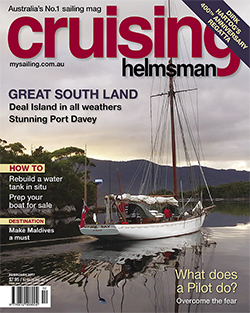
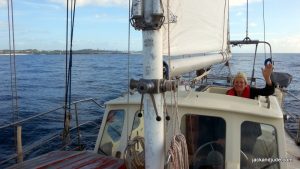
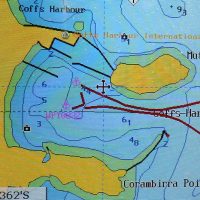


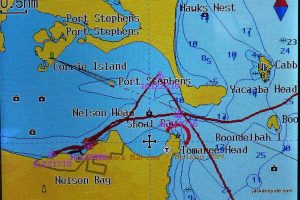
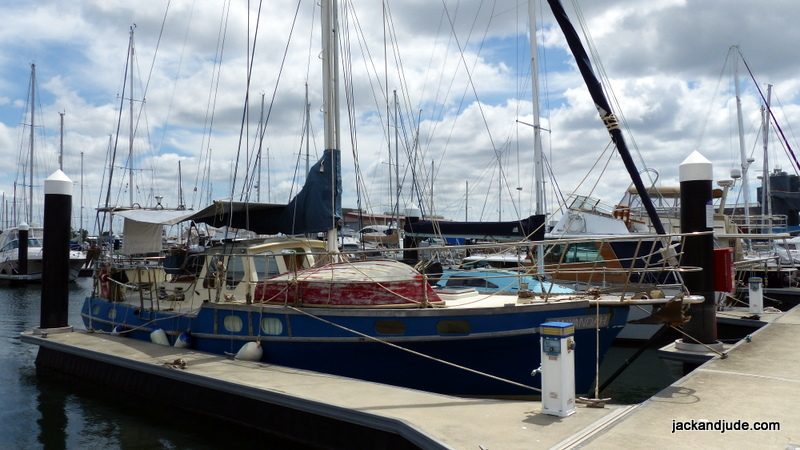
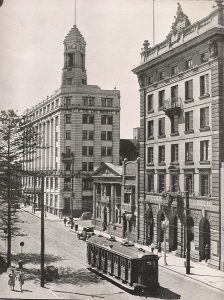
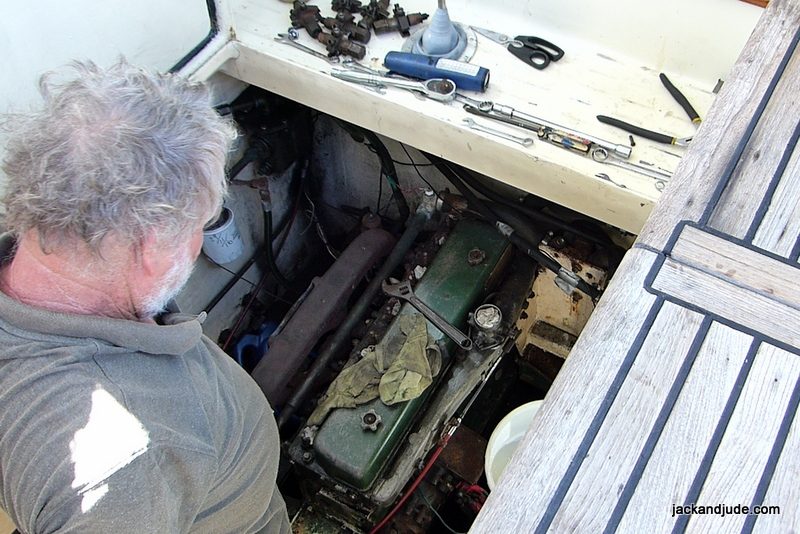
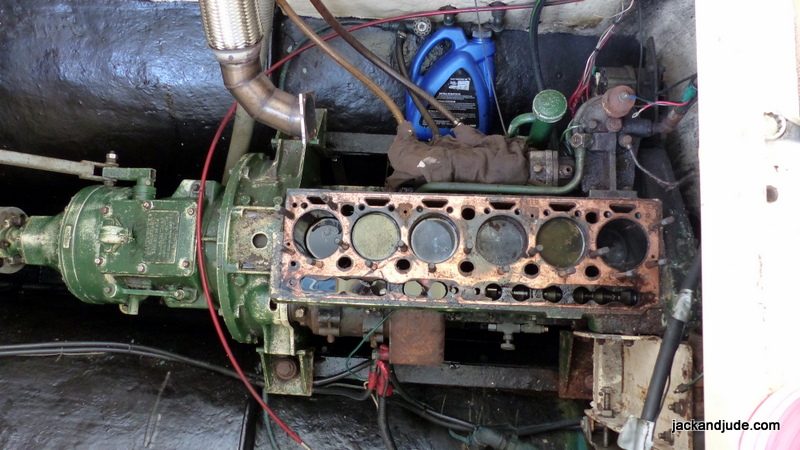
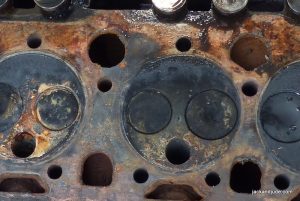
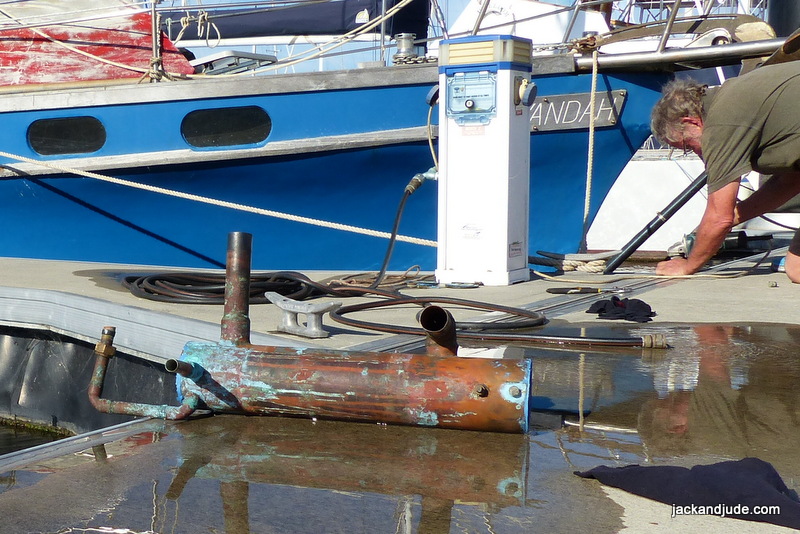
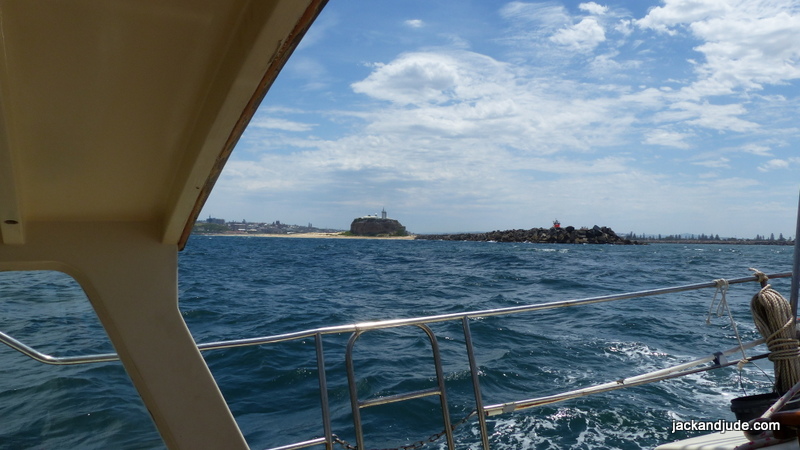
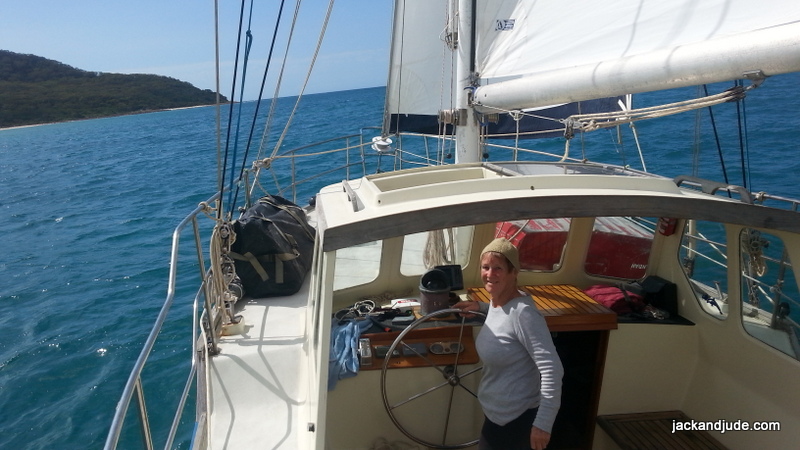
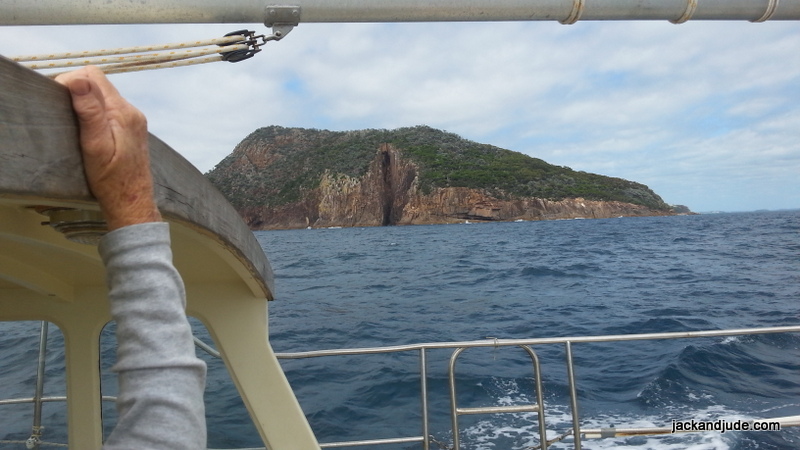
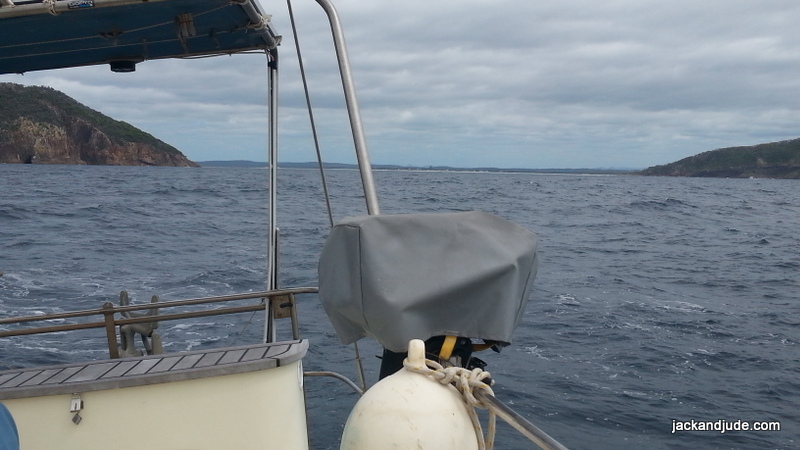
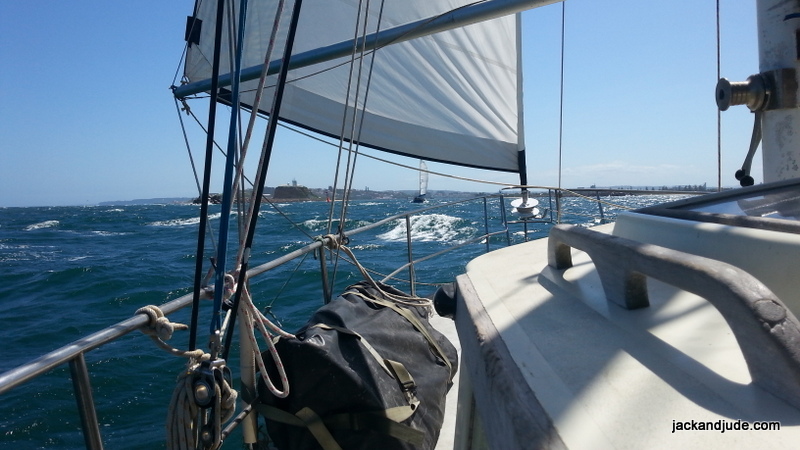
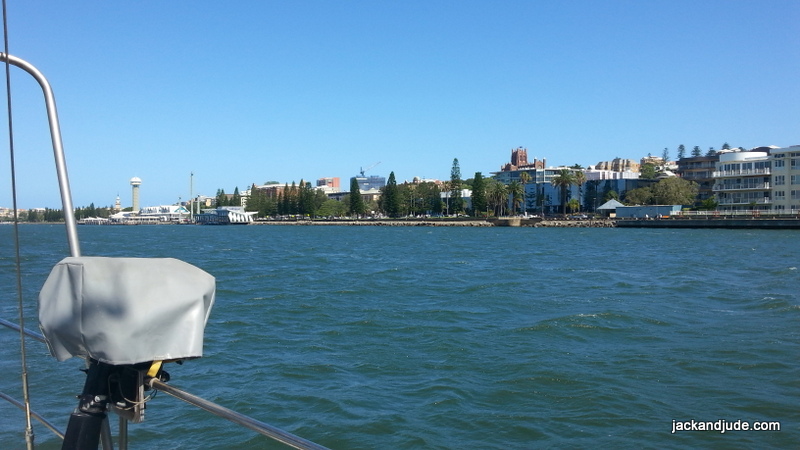
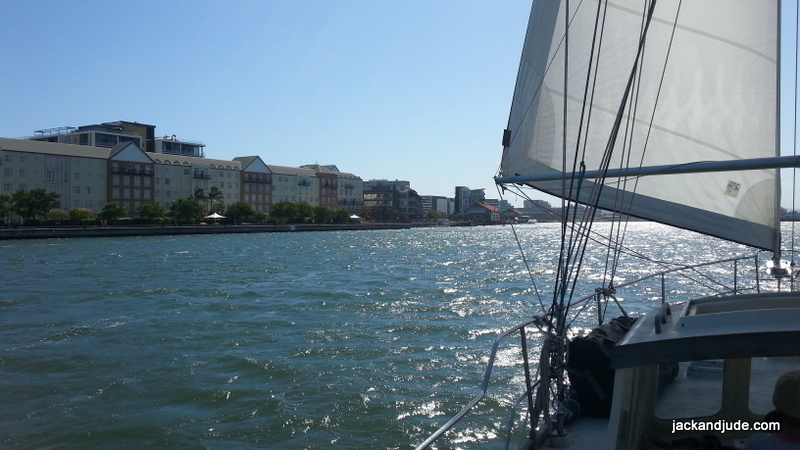
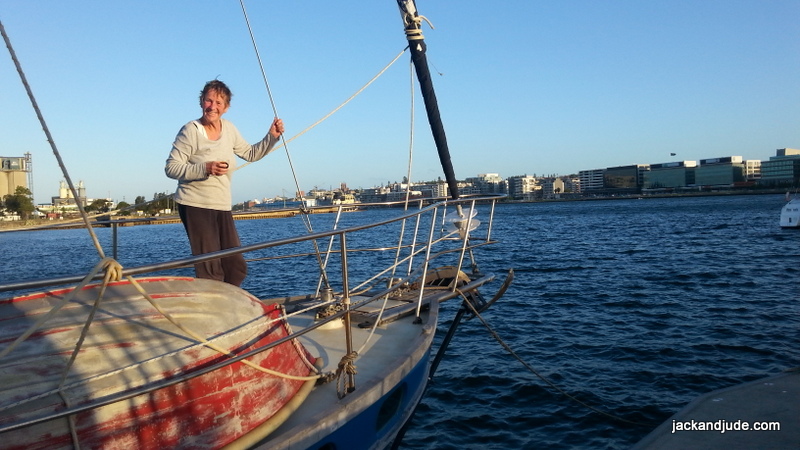
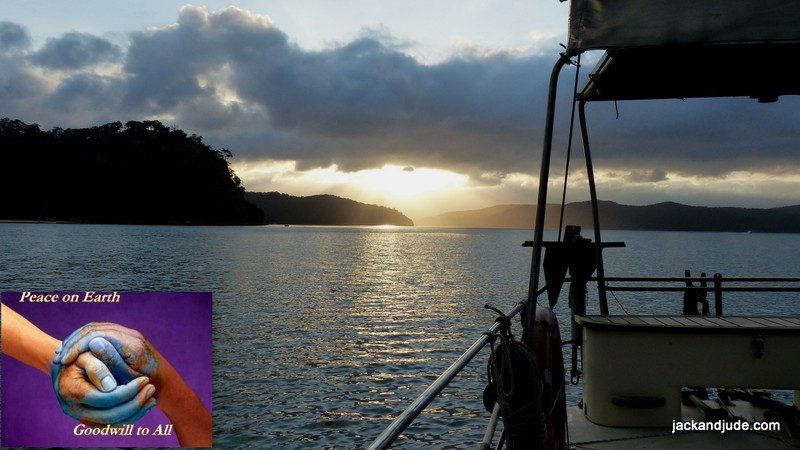




Thank you Jack and Jude,
I loved your blog. It was my first. You have inspired me to return to work on my boat to get it relaunched. (I only stoped for an hour or two because of the heat here in South Australia today) Gave me a chance to catch up on mail.
Cheers Clive
Welcome aboard Clive, always delighted to provide a bit of inspiration, we all need it. Bless that SA heat, good for baking bread….
Hi Jack and Jude,
just happened to read your latest blog post and we are very excited for you, and hoping the good old engine lasts this time. We are planning to take off from Gladstone in late March to cruise around Great Barrier Reef – maybe see you along the way?
Big hugs from Anni, Matt and the kids (SV Iron Will)
Hi Anni and Matt
It’d be fantastic to share a few more anchorages with you guys- Boy, we’d really love that. But we’re heading in the opposite direction right now. Can’t wait to hear how it goes for you cruising with the kids. We know it’ll be a magic time. Hey, a boat next to us has 10, yes 10, kids on board! Yiks! Aah but they’re laughing and have a rollicking good time. Magic.